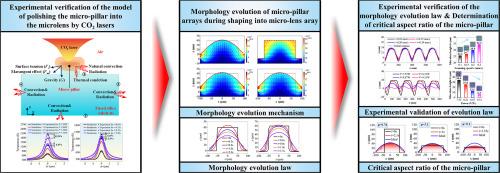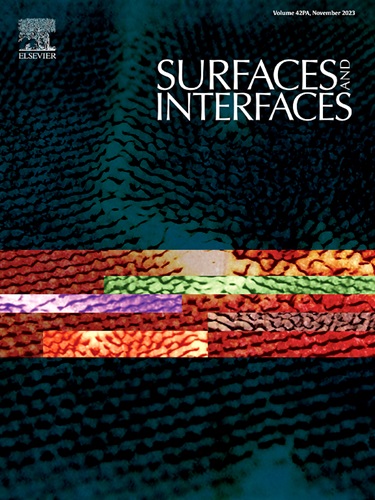通过二氧化碳激光抛光将熔融石英表面的微柱阵列塑造成微透镜阵列的微结构形态演变机制
IF 6.3
2区 材料科学
Q2 CHEMISTRY, PHYSICAL
引用次数: 0
摘要
硬脆熔融石英表面上的周期性微柱可通过二氧化碳激光抛光形成光滑无缺陷的微透镜阵列(MLA),从而应用于成像和光束整形。然而,抛光过程中微柱的形貌演变机制并不清晰,这严重影响了高质量微透镜阵列的快速制备。本文建立了一个多物理场耦合模型来研究 CO2 激光与熔融石英表面微柱之间的相互作用,并从时间和空间温度的角度进行了验证。探究了表面温度随激光功率和光斑半径的稳定演变规律,并据此确定了抛光参数 "Window",使材料熔化并流动而不被烧蚀去除。研究了微柱的形态演变以及激光与材料的相互作用。研究发现,在激光照射下,微柱高度先增大后减小,其顶部曲率半径增大。微柱材料的熔化和流动主要受表面张力的影响,而马兰戈尼效应和重力的影响很小。此外,为了制造具有特定尺寸的目标 MLA,还研究了微柱长宽比(φ)对微透镜表面形态的影响。研究发现,目标 MLA 有两个临界 φ。对于目标周期为 200 μm、目标高度为 40 μm 的所需 MLA,当 φ 大于 5.1 时,微柱阵列无法通过 CO2 激光抛光成型为目标 MLA。随着 φ 的减小,微柱与基板的交界处明显向下凹陷,成型轮廓与理想球形轮廓之间的偏差增大。为了成功制备目标 MLA 并保证几何精度,选择最小 φ 为 0.71。这项工作对于通过 CO2 激光非蒸发抛光获得光滑、无缺陷、具有特定尺寸的目标熔融石英 MLA 具有重要的理论意义。本文章由计算机程序翻译,如有差异,请以英文原文为准。

Morphological evolution mechanism of microstructures involved in shaping micro-pillar arrays into microlens arrays on fused silica surfaces by CO2 laser polishing
The periodic micro-pillars on the hard-brittle fused silica surface can be shaped into the smooth and defect-free microlens arrays (MLA) by CO2 laser polishing, which can be applied in imaging and beam-shaping. However, the morphology evolution mechanism of the micro-pillars is not clear during polishing, which seriously affects the rapid preparation of high-quality MLAs. Herein, a multi-physics coupling model is established to investigate the interaction between CO2 lasers and micro-pillars on the fused silica surface, and is verified from the perspectives of temporal and spatial temperature. The steady surface temperature evolution law with laser power and spot radius is explored, based on which, the parameter ‘Window’ for polishing is determined to make the material melt and flow without ablation removal. The morphology evolution of micro-pillars is investigated as well as laser-material interaction. It is found that under laser irradiation, the micro-pillar height first increases and then decreases, and its top curvature radius increases. The surface tension makes the dominant contributions to the melting and flow of the micro-pillar materials, while the Marangoni effect and the gravity have little effect. Furthermore, to fabricate the target MLAs with the specific dimensions, the influence of micro-pillar aspect ratio (φ) on microlens surface morphology is investigated. It is found that there are two critical φ for the target MLAs. For the required MLA with the target period of 200 μm and the target height of 40 μm, when the φ is larger than 5.1, the micro-pillar array fails to be shaped into the target MLA by CO2 laser polishing. As the φ decreases, the junction of micro-pillar and the substrate sags downwards significantly, and the deviation between the shaped- and the ideal spherical contours increases. To successfully prepared the target MLA and guarantee the geometry accuracy, the minimum φ is selected to be 0.71. This work has important theoretical significance for obtaining the smooth and defect-free target fused silica MLAs with the specific dimensions by CO2 laser non-evaporative polishing.
求助全文
通过发布文献求助,成功后即可免费获取论文全文。
去求助
来源期刊

Surfaces and Interfaces
Chemistry-General Chemistry
CiteScore
8.50
自引率
6.50%
发文量
753
审稿时长
35 days
期刊介绍:
The aim of the journal is to provide a respectful outlet for ''sound science'' papers in all research areas on surfaces and interfaces. We define sound science papers as papers that describe new and well-executed research, but that do not necessarily provide brand new insights or are merely a description of research results.
Surfaces and Interfaces publishes research papers in all fields of surface science which may not always find the right home on first submission to our Elsevier sister journals (Applied Surface, Surface and Coatings Technology, Thin Solid Films)
 求助内容:
求助内容: 应助结果提醒方式:
应助结果提醒方式:


